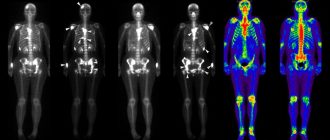PSA for prostate cancer is one of the most reliable tests for diagnosing the oncological process and monitoring its therapy. To take the test, you need to start the preparatory process 2-3 weeks in advance, because the indicators can fluctuate from many factors, which will give incorrect diagnostic results. To donate, a small amount of blood is taken; it is advisable to repeat the procedure at least once a year; this will make it possible not only to control the level of the indicator, but also to observe its dynamics. The PSA value will help determine not only the presence, but also the stage of the oncological process, as well as the effectiveness of its treatment.
What does PSA show?
PSA (prostate specific antigen) is a specific protein produced by the prostate gland. It is contained in the ejaculate, but sometimes, in small quantities, enters the blood. As the cancer process progresses, the level of PSA in the blood increases.
Such diagnostics are very important for men over 40 years of age. They are recommended to undergo examination at least once a year, because with age the risk of oncological processes increases, and their initial stages are asymptomatic, which complicates other types of diagnosis. According to statistics, about 50% of men learn about the presence of prostate cancer during regular examination. But, if the requirements before the examination are violated, the analysis can give a false positive or false negative result.
Indications
A PSA blood test is performed in the following cases:
- Regular diagnostics.
- Suspicion of the presence of cancer or adenoma after palpation or other instrumental examinations.
- When complaining about characteristic symptoms.
- Tracking dynamics during the treatment of an already diagnosed disease.
Contraindications
There are no direct contraindications for the examination. However, the diagnosis will show false results in the following cases:
- Carrying out a biopsy or laser surgery 4-6 weeks before donating blood for prostate-specific antigen.
- Cytoscopy, TRUS or palpation of the prostate within 2 weeks.
- Transurethral resection of the prostate for six months.
- Recent colonoscopy or ergometry.
Preparing for a PSA test
To obtain reliable results, you must adhere to certain requirements.
2-3 weeks before the examination you should:
- Avoid drugs that increase potency or testosterone levels. Other medications taken should be discussed with your doctor.
- Avoid any examinations that affect the organ (palpation, TRUS, massages).
- Remove the catheter from the bladder, if present.
2 days before the examination you should:
- Avoid fried, spicy, salty and smoked foods, as well as coffee and alcohol.
- Abstain from sexual intercourse.
- Avoid physical activity, especially cycling and horse riding.
- Avoid stressful situations.
- Stop smoking.
It is also worth considering that the analysis is performed on an empty stomach; you should refrain from eating 12 hours before donating blood. During the sampling, you should remain calm, because sharp negative emotions can affect the indicators, which will reduce the accuracy of the diagnosis.
PSA test
To take the test, a small volume of venous blood, about 5-10 ml, is required. The procedure can be performed at any blood testing center. For this purpose, the patient is placed in a sitting position, or in case of nervousness or dizziness - lying down. It is very important to be in a calm state, otherwise the results may be inconsistent. In this case, a repeat blood draw may be scheduled after some time.
Decoding and PSA norms
A negative tumor marker test will show no more than 4 ng/ml, but this indicator depends on age:
- From 40 to 50 years - the norm is 2.5 ng/ml;
- From 50 to 60 - 3.5 ng/ml;
- From 60 to 69 - 4.5 ng/ml;
- over 70—6.5 ng/ml.
Prostate cancer is also possible with low antigen levels, so values between the norm and 10 ng/ml are considered to be the border zone. With such values, additional examinations are carried out, often a biopsy.
PSA values for prostate cancer should also not increase by more than 0.75 ng/ml per year, even if the values are within normal limits. Otherwise, the patient is sent for additional diagnostics if the oncological process is not confirmed or the treatment is considered ineffective.
Prostate cancer stages and PSA levels
Normal PSA in prostate cancer is differentiated depending on the stage of the oncological process.
Results for stage 1 prostate cancer usually range from 6-8 ng/ml. The tumor is still small in size, the pathology is asymptomatic.
At the 2nd stage, the tumors increase in size, but remain within the prostate gland. You may feel discomfort or pain when urinating and during sexual intercourse. Indicators of prostate specific antigen at the 2nd stage of cancer are 10-20 ng/ml.
At stage 3, the tumor grows beyond the prostate membrane, metastases can be found in nearby tissues. PSA exceeds 20 ng/ml.
At stage 4, metastases can be detected in lymph nodes distant from the gland, the prostate specific antigen level exceeds 40 ng/ml.
PSA after cancer removal
The tumor marker level after removal of prostate cancer is considered normal if it does not exceed 0.2-0.7 ng/ml. At higher values, a relapse is diagnosed, and additional examinations and therapy are prescribed.
If the resection was carried out partially and after several months the indicator has not returned to normal, additional examination and subsequent therapy are prescribed.
PSA after brachytherapy
The tumor marker decreases gradually after brachytherapy. The dynamics of the decrease allows us to draw conclusions about the effectiveness of treatment. Prostate-specific antigen after radiation therapy decreases by 1 ng/ml. With this value, the risk of relapse over the next 5 years is low.
The normal prostate-specific antigen level after irradiation for prostate cancer is achieved 2-3 years after therapy. There are also a number of ways to lower tumor markers yourself.



